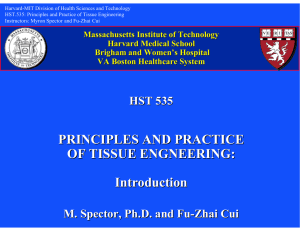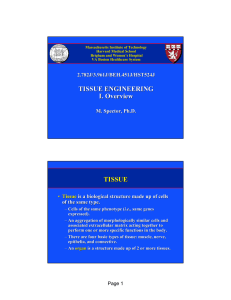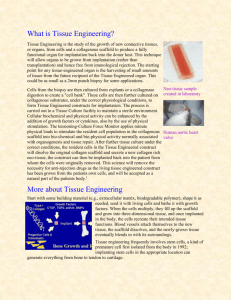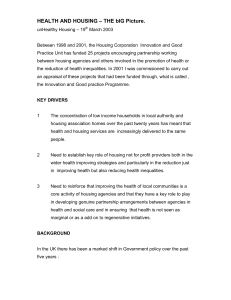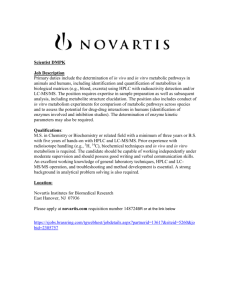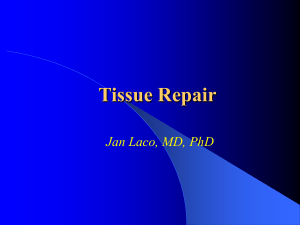Massachusetts Institute of Technology Harvard Medical School Brigham and Women’s Hospital
advertisement
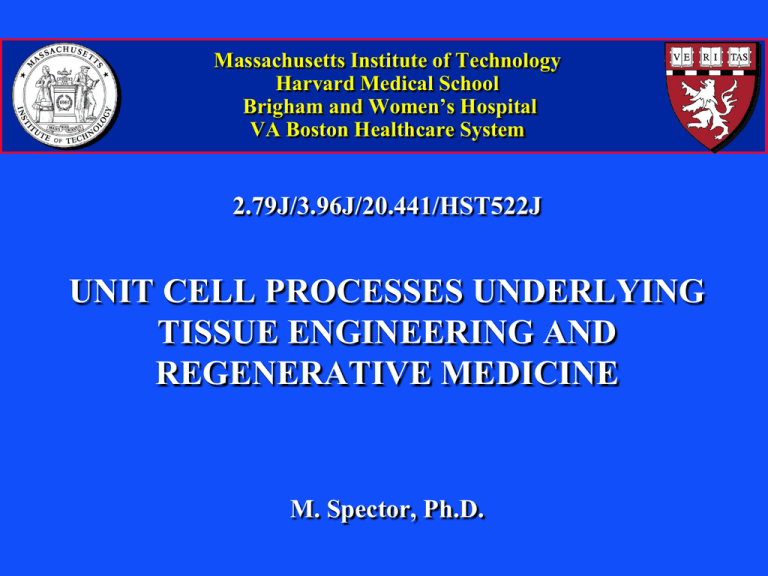
Massachusetts Institute of Technology Harvard Medical School Brigham and Women’s Hospital VA Boston Healthcare System 2.79J/3.96J/20.441/HST522J UNIT CELL PROCESSES UNDERLYING TISSUE ENGINEERING AND REGENERATIVE MEDICINE M. Spector, Ph.D. TISSUE ENGINEERING/ REGENERATIVE MEDICINE Reg. Unit Cell Processes Cell + ECM Formation Cell + ECM Migration Mitosis Prod. + Reg. Prod. + Reg. Synthesis: ECM Cell + ECM Remodeling Degradation Cell + ECM Prod. + Reg. Synthesis: Enzyme Prod. + Reg. Contraction Cell + ECM Generally inhibits regeneration Prod. + Reg. TISSUE ENGINEERING • • • • What is tissue engineering? Production of tissue in vitro by growing cells in porous, absorbable scaffolds (matrices). Why is tissue engineering necessary? Most tissues cannot regenerate when injured or diseased. Even tissues that can regenerate spontaneously may not completely do so in large defects (e.g., bone). Replacement of tissue with permanent implants is greatly limited. TISSUE ENGINEERING Problems with Tissue Engineering • Most tissues cannot yet be produced by tissue engineering (i.e., in vitro). • Implantation of tissues produced in vitro may not remodel in vivo and may not become integrated with (bonded to) host tissue in the body. Solution • Use of implants to facilitate formation (regeneration) of tissue in vivo. – “Regenerative Medicine” – Scaffold-based regenerative medicine TISSUE ENGINEERING VS. REGENERATIVE MEDICINE* TISSUE ENGINEERING REGENERATIVE MED. Regeneration In Vitro Regeneration In Vivo Produce the fully formed Implant the biomaterial tissue in vitro by seeding matrix with, or without cells into a biomaterial seeded cells, into the body matrix, and then to facilitate regeneration implant the regenerated of the tissue in vivo. tissue into the body. TISSUE ENGINEERING VS. REGENERATIVE MEDICINE TISSUE ENGINEERING Regeneration In Vitro Advantages • Evaluation of tissue prior to implantation Disadvantages • For incorporation, must be remodeling • Stress-induced architecture cannot yet be produced in vitro REGENERATIVE MED. Regeneration In Vivo Advantages • Incorporation and formation under the influence of endogenous regulators (including mechanical strains) Disadvantages • Dislodgment and degrad. by mech. stresses in vivo TISSUE ENGINEERING Current Status • No one has yet employed Tissue Engineering methods to fully regenerate any tissue that does not have the capability for spontaneous regeneration*. – The Integra skin has no hair or glandular structures and its architecture is close to but not identical to normal dermis. – The Carticel cartilage is not articular cartilage. • Experience has taught us that full regeneration may not be necessary to achieve a meaningful clinical result (e.g., pain relief, recovery of function, esthetics) • How close to regeneration is good enough? * Many examples of bone regeneration TISSUE ENGINEERING ENDPOINTS • Morphological/Histological/Biochemical – Match the composition and architecture of the tissue. – Problem: A complete analysis is difficult and no clear relationships yet with functional and clinical endpoints. • Functional – Achieve certain functions; display certain properties (e.g., mechanical properties). – Problem: Difficult to measure all properties; Which properties are the most important? • Clinical – Pain relief. – Problems: Can only be evaluated in human subjects and the mechanisms (including the placebo effect) and kinetics of pain relief (e.g., how long it will last) are unknown. ELEMENTS* OF TISSUE ENGINEERING/ REGENERATIVE MEDICINE • MATRIX (SCAFFOLD) – Porous, absorbable synthetic (e.g., polyglycolic acid) and natural (e.g., collagen) biomaterials • CELLS (Autologous or Allogeneic) – Differentiated cells of same type as tissue – Stem cells (e.g., bone marrow-derived) – Other cell types (e.g., dermal cells) • REGULATORS – Growth factors or their genes – Mechanical loading – Static versus dynamic culture (“bioreactor”) * Used individually or in combination, but often with a scaffold) TECHNOLOGY TOOL BOX TISSUE ENGR./REGENERATIVE MED. • SCAFFOLD (MATRIX) – Porous, absorbable biomaterial; can serve to regulate cell function prior to is its absorption • CELLS • REGULATORS – Cytokines (growth factors) – Genes for growth factors – Antagonists of inhibitors – Fluid flow – Mechanical loading – Hydrostatic pressure – Shock wave and ultrasound – Electromagnetic radiation and magnetic fields CELL THERAPY FOR LOCAL REPAIR* • • • • • • Injection of Exogenous Cells; Cells Expanded in Number in Monolayer Culture Chondrocytes for cartilage repair (FDA-approved) Intervertebral disc cells for herniated disc (human trial) Myoblasts and stem cells for myocardial infarction (human trial) Cells injected into the brain (human) Stem cells into spinal cord lesions (animal) Cells into the retina (animal) * An alternative strategy is to implant a scaffold seeded with the cells Arthroscopic Debridement “Microfracture” Osteochondral Osteocho Osteochondral Plug Autograft Plug PlugAuto Autograft (“Mosaicplasty”) (“Mosaicplasty”) (“Mosaicpl Figure by MIT OpenCourseWare. 30 years Total Knee Replacement Current Clinical Practice Autologous chondrocytes injected under a periosteal flap (Genzyme; “Carticel”) Medical illustrations removed due to copyright restrictions. Articular Cartilage Cartilage Articular Extracellular Matrix Figure by MIT OpenCourseWare. Cell 4 mm 10 mm Autologous Chondrocyte Implantation Problems with the periosteum? Image removed due to copyright restrictions. Figure 1 in Brittberg, M., et al. “Treatment of Deep Cartilage Defects in the Knee with Autologous Chondrocyte Transplantation.” NEJM 331, no. 14 (1994): 889-895. http://content.nejm.org/cgi/content/abstract/331/14/889 This process has been commercialized by Genzyme (for $20,000). M Brittberg, et al., NEJM 33:889 (1994) Collagen membrane to replace a periosteal tissue graft to contain injected autologous chondrocytes (grown in culture) Debridement Images removed due to copyright restrictions. Implantation of a collagen membrane to contain injected autologous chondrocytes Future Clinical Practice Implementing Tissue Engineering Implantation of a cell-seeded matrix Figure by MIT OpenCourseWare. “Microfracture”: Stem cells from bone marrow infiltrate the defect Implantation of the matrix alone, (or supplemented with growth factors or genes for the GFs) CELLS FOR TISSUE ENGINEERING/REGENERATIVE MEDICINE • Autologous (from same individual) – Differentiated cells of same or other tissue type – Stem cells (adult) • Allogeneic (from another individual) – Same as above – Fetal stem cells – Embryonic stem cells TISSUE ENGINEERING Issues to be Addressed • Should the tissue be produced in vitro, for subsequent implantation, or in vivo? • What scaffold should be used? – Material of fabrication, pore characteristics, absorbability, mechanical properties? – How to be manufactured? • What cells are to be used? – Source of cells? – Under what conditions can cells be expanded in number in vitro while retaining their phenotype? • What regulators are required to stimulate cell proliferation and matrix synthesis or to facilitate differentiation of stem cells? Which Tissues Can Regenerate Spontaneously? Yes No Connective Tissues • Bone • Articular Cartilage, Ligament, Intervertebral Disc, Others Epithelia (e.g., epidermis) √ √ √ Muscle √ • Cardiac, Skeletal • Smooth Nerve √ √ FACTORS THAT CAN PREVENT REGENERATION • Size of defect – e.g., bone does not regenerate in large defects • Collapse of surrounding tissue into the defect – e.g., periodontal defects • Excessive strains in the reparative tissue – e.g., unstable fractures UNIT CELL PROCESSES FOR TISSUE REGENERATION Regulator UCP Cell + Matrix Connective ECM Tissue Adhesion Epithelia Protein Muscle Collagen Nerve Biomaterial Integrin Product + Regulator Mitosis Synthesis Migration Contraction Endocytosis Exocytosis CELL-MATRIX INTERACTIONS REQUIRED FOR TISSUE ENGINEERING Connective Tissues (Musculoskeletal) Mitosis1 Migration2 Synthesis3 Contract.4 Bone + + + + Articular Cartilage Ligament/Tendon Intervertebral Disc Meniscus 1 Inadequate + ? -/+ -/+ ? ? ? ? ? + + + + mitosis requires exogenous cells. 2 Inadequate migration may require a scaffold (viz., when no clot). 3 Inadequate biosynthesis require growth factors or their genes. 4 Contraction ? ELEMENTS OF TISSUE ENGINEERING/ REGENERATIVE MEDICINE • MATRIX (SCAFFOLD) – Porous, absorbable synthetic (e.g., polyglycolic acid) and natural (e.g., collagen) biomaterials • CELLS (Autologous or Allogeneic) – Differentiated cells of same type as tissue – Stem cells (e.g., bone marrow-derived) – Other cell types (e.g., dermal cells) • REGULATORS – Growth factors or their genes – Mechanical loading – Static versus dynamic culture (“bioreactor”) * Used individually or in combination, but often with a scaffold) ROLES OF THE BIOMATERIALS/ SCAFFOLDS 1) the scaffold serves as a framework to support cell migration into the defect from surrounding tissues; especially important when a fibrin clot is absent. 2) serves as a delivery vehicle for exogenous cells, growth factors, and genes. 3) before it is absorbed a scaffold can serve as a matrix for cell adhesion to facilitate/“regulate” certain unit cell processes (e.g., mitosis, synthesis, migration) of cells in vivo or for cells seeded in vitro. a) the biomaterial may have ligands for cell receptors (integrins) b) the biomaterial may selectively adsorb adhesion proteins to which cells can bind 4) may structurally reinforce the defect to maintain the shape of the defect and prevent distortion of surrounding tissue. 5) serves as a barrier to prevent the infiltration of surrounding tissue that may impede the process of regeneration. MIT OpenCourseWare http://ocw.mit.edu 20.441J / 2.79J / 3.96J / HST.522J Biomaterials-Tissue Interactions Fall 2009 For information about citing these materials or our Terms of Use, visit: http://ocw.mit.edu/terms.
